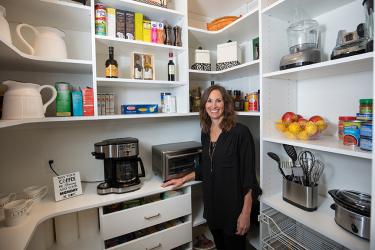SLHL: What is your number one tip for pantry design?
Karen: Whether you have a small reach-in pantry or large walk-in pantry, my number one tip is to have adjustable shelves and use them wisely. When you place similar height items on each shelf, then you can maximize the height of the entire unit.
SLHL: How do you start to organize your pantry?
Karen: The best way to organize your pantry is to keep your items in categories. Noodles with noodles and canned goods with canned goods. This way, you will not only know what you have, but also the space will seem less chaotic. Take inventory and keep or buy items that you eat or use. So many times we go to the store and buy the same things over and over again, which can be both wasteful and frustrating.
SLHL: What is the biggest challenge when it comes to food storage in a pantry?
Karen: We become easily overwhelmed in a disorderly space. Understanding how you use your pantry is key to designing one that fits your lifestyle. We can add features that maximize efficiency. Then, if we build a space that meets each home’s needs and we mindfully put our items into the space, then the space begins to work for the user.
SLHL: What is the best way to utilize every inch of space in the kitchen pantry?
Karen: Keep similar height/size items on the same shelves. This way, you don’t lose space between the shelves. If you have a tall cereal box next to a soup can, you will lose so much space between the soup can and the bottom of the next shelf. Adjust the shelves based on the heights of the items on the shelves. Also, it sounds counterintuitive, but shallow shelves in a pantry are extremely useful. This way, you don’t “lose” items behind each other.
SLHL: What are the different storage types and what is the best application?
Karen: Built-in features offer the most useful storage, but the type varies from client to client. Slide-out baskets are great for items that don’t have a shape, like chip bags or individually wrapped snacks. With a basket, you can see exactly what you have. Half-faced drawers or sliding shelves are perfect for canned goods or small boxes. You don’t lose things behind each other when you can slide out and see it all. Full-faced drawers are great for items that you don’t want to see or are smaller items. Not everything in a pantry is square, so corner shelves allow you to store items that are bulky and more circular like slow cookers or soup pots. Dividers help organize your trays and baking gear.
SLHL: What tools keep your kitchen cabinets and drawers most organized?
Karen: Built-in storage keeps the cabinets and drawers most organized. The materials are built specifically for the space, so there isn’t unused space.
SLHL: What is the newest/best accessory for the pantry?
Karen: The trend is to have less clutter on kitchen countertops, but we still need access to small appliances that we use daily. By putting a landing area in a pantry, we can still have our appliances conveniently located, but we don’t have to look at them all of the time.
SLHL: What is the most durable finish/material to use?
Karen: Melamine is extremely easy to clean, durable and sturdy.
SLHL: What would a luxury pantry include if space and price weren’t an issue?
Karen: Every space in our home is so personal and a pantry can reflect the aesthetic throughout the rest of a home. A space can look beautiful, but if it doesn’t make sense for the way you live your life, it is useless. A luxury pantry would consider both form and function.
Resources
Beyond Storage, 314-997-0150





